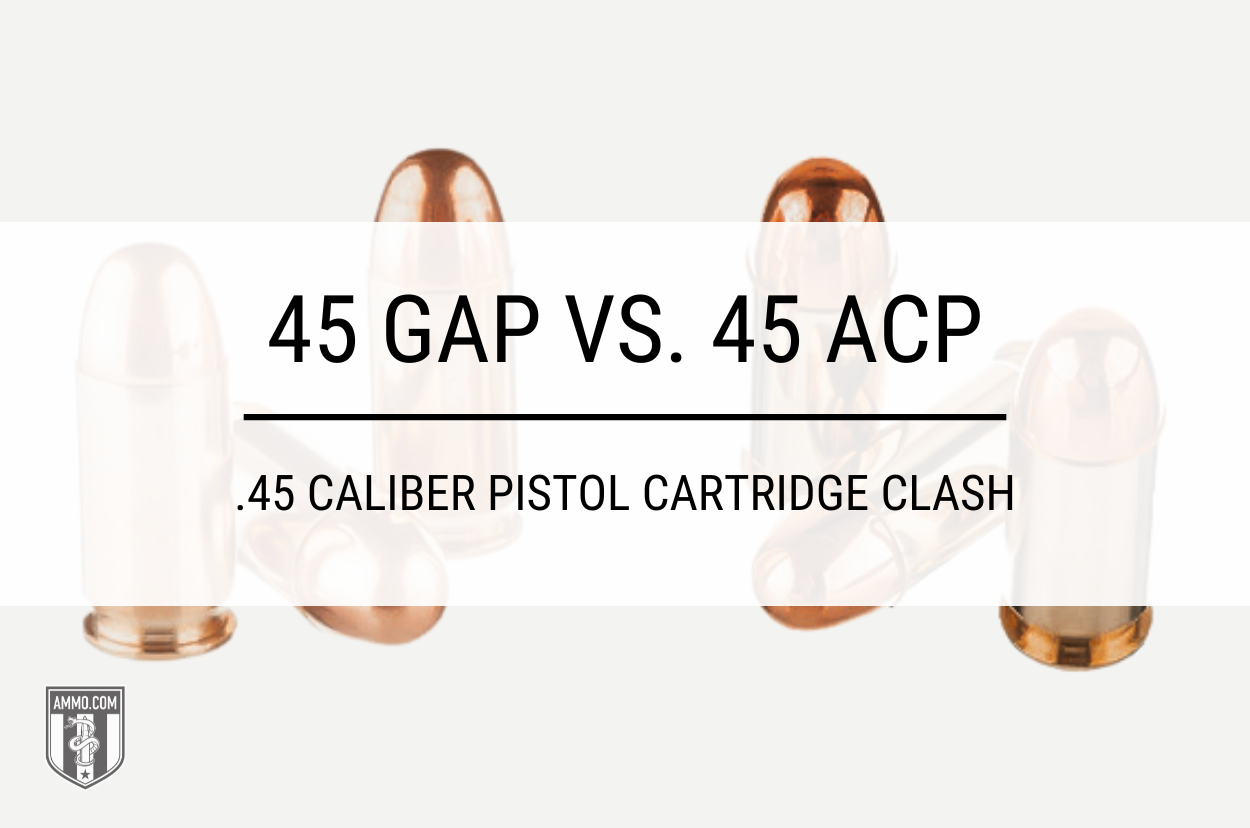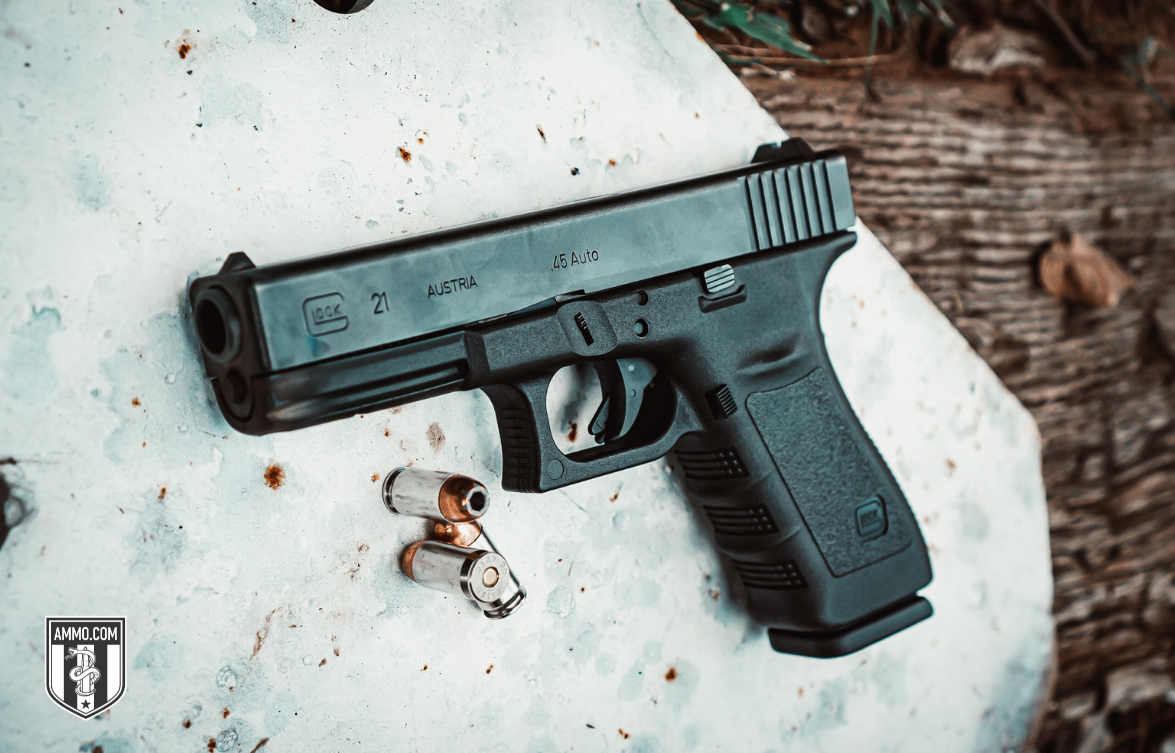45 GAP vs 45 ACP: .45 Caliber Pistol Cartridge Clash

Many have tried – and all have failed – to replace the legendary .45 ACP round. Discover why the 45 Automatic Colt Pistol cartridge reigns supreme when we compare and contrast it to 45 GAP in real-world scenarios.
We’ll pit the cartridges head-to-head, comparing recoil, accuracy, stopping power, self-defense, overall cost and availability, and reloadability.
Let’s get started with the differences between these .45 cal cartridges.
What’s the Difference Between 45 ACP and 45 GAP?
The 45 ACP and 45 GAP are not the same cartridge. There are significant differences between the two.
The 45 Glock Automatic Pistol cartridge was designed to fill the void between the 45 ACP and 9mm. Firing virtually the same diameter bullet as the 45 ACP, the 45 GAP maintains similar energy levels while taking advantage of a smaller case length, making it perfect for concealed carry in compact pistols.
Just how much more compact is the 45 GAP round compared to the 45 ACP? Continue reading to find out!
Cartridge Specs
Since the 45 GAP was based on the 45 ACP, we can expect some similarities, such as similar bullet weights (165 grain to 230 grain for 45 GAP, and 68 grain to 300 grain for the 45 ACP – although most are 185 grain to 230 grain) and diameters (0.451 in for the 45 GAP and 0.452 in for the 45 ACP).
The most significant difference in size is in the case length. The 45 GAP has a shorter 0.755 in case, whereas the 45 ACP is 0.898 in. This translates into a longer overall length for the 45 ACP (1.275 in compared to 1.070 in).
To maintain similar ballistic performance, the creator of the 45 GAP cartridge (Ernest Durham) designed it with a higher maximum pressure. The 45 GAP has a max pressure of 23,000 psi; the 45 ACP has 21,000 psi.

Let’s see how these specifications affect real-world performance.
Recoil: 45 GAP vs. 45 ACP
Recoil is an important consideration when purchasing a new self-defense handgun. A round with heavy recoil is more challenging to control and will slow your follow-up shots.
Muzzle velocity (fps), bullet weight, propellant charge weight, and handgun weight all determine recoil. Felt recoil varies from shooter to shooter and cannot be objectively measured. Recoil energy, on the other hand, is quantifiable.
The recoil energy of the 45 ACP is generally 7-8 ft-lbs, depending on the exact load and firearm. The recoil energy of the 45 GAP is around 8 ft-lbs – again depending on your chosen load.
While you might notice a slight difference in recoil, these cartridges kick pretty much the same. This section is a tie because the difference in recoil is so minor.
Accuracy
It should go without saying that we want the most accurate round possible, especially in a home defense situation. Many factors contribute to a cartridge's accuracy, such as the recoil, trajectory, shooter, firearm, and shooting conditions.
For instance, it’s much easier to be accurate with a 45 ACP carbine than a 45 ACP pistol, even when using the same ammo because of the carbine’s longer barrel.
When all the controllable factors are as equal as possible, shooters will have difficulty determining which .45 caliber handgun cartridge is more accurate.
This section is a tie because both cartridges can be very accurate in the hands of a capable shooter.
Stopping Power: 45 ACP vs. 45 GAP
If you want to start an argument at the gun store or on a gun forum, mention stopping power. It is unquantifiable, as it is ultimately determined by shot placement. A well-placed shot with a small (less powerful) cartridge will always be more effective at stopping a threat than a poorly placed shot with a larger (more powerful) cartridge.
We can argue about bullet hole size, penetration depth, and energy transfer capabilities until we’re blue in the face and still disagree. Luckily, these two cartridges typically use the same bullets at similar velocities, making them simple to compare.
The 45 ACP has a slight edge when firing lighter projectiles, but the roles are reversed when using heavier bullets. However, neither cartridge jumps way ahead of the other in either scenario.
This section is also a tie. With proper shot placement, both cartridges have very similar stopping power.
Hunting

Neither cartridge was designed for hunting, but the 45 ACP is occasionally used for bear defense and dispatching wild hogs.
Besides carrying a backup pistol for defense, I don’t recommend hunting with either cartridge. If I were forced to choose between the 45 GAP and 45 ACP, I would choose the 45 ACP because there are many more firearm and ammo options on the market.
The 45 ACP wins this section by a slight margin.
Self-Defense: 45 Glock Auto Pistol vs. 45 Automatic Colt Pistol
We’re finally at the section where both cartridges shine – but which shines brighter?
The 45 GAP was designed as the ultimate concealed carry cartridge. It fits in more compact pistols, which are easier to conceal without printing, and it doesn’t sacrifice stopping power.
The 45 ACP has been time-tested through multiple wars and utilized by law enforcement and civilians to stop threats for decades.
While the 45 GAP initially looked like it could overtake the 45 ACP, it didn’t offer shooters enough justification to switch. It died off almost as quickly as it exploded onto the scene, as did ammo and firearm options.
The 45 ACP won this section because it’s proven itself throughout history, and the countless ammo and gun options mean you can find the perfect 45 ACP setup.
Cost & Availability

If you’re scanning this article, you probably missed that the 45 ACP has a much more comprehensive selection of guns and ammo. But I’m sure you could have guessed that by checking at your local gun store.
The price of firearms is very similar, but only Glock currently manufactures firearms chambered in .45 GAP, whereas virtually every US firearm manufacturer known to man produces a gun chambered in .45 ACP. Springfield Armory had an XD series pistol chambered in .45 GAP but discontinued it after low demand.
The 45 ACP takes another leap ahead of the 45 GAP regarding ammo cost and availability. Not only is 45 ACP ammo more abundant, but it also offers more bullet options and is less expensive for comparable loads.
The 45 ACP wins this section by a landslide.
Reloading
Reloading is the way to go if you’re looking to save money on ammo or craft the perfect round for your firearm. Handloading allows you to dial in the ideal combination to get the ultimate performance out of each round.
While purchasing the reloading equipment and supplies is costly initially, your savings drastically increase when purchasing bulk ammo and reloading the spent casings.
The 45 ACP is more accessible for reloading in the sense that there are more load data and supplies available, but the 45 GAP can be reloaded, too. Reloading is often the only way you’ll have ammo on hand for the .45 GAP.
This section is a tie, as both cartridges can be reloaded with roughly the same effort.
45 GAP vs. 45 ACP Ballistics Tables
We finally made it to the section that all the number crunchers love: the ballistics section. The team at Ammo.com has compiled the ballistics of each cartridge in easy-to-read tables so you can quickly compare how similar these .45 caliber cartridges are to one another.
45 GAP Ballistics Tables

45 ACP Ballistics Tables

Don’t miss these 45 ACP ballistics tables for a deeper dive into 45 ACP performance.
45 GAP Brief History
Glock set out to make a .45 caliber cartridge that could be used in a compact handgun without an oversized grip. This allows the handgun to be carried concealed and used comfortably by most shooters. In 2003, Glock released the Glock 37 and collaborated with Speer to create the ammo.
The public’s initial response to the 45 GAP was generally positive, and a few other firearm manufacturers besides Glock produced .45 GAP pistols. However, as time passed, many 45 GAP firearms were discontinued, and Glock is currently the only manufacturer of 45 GAP handguns.
Today, a few law enforcement agencies still issue 45 GAP pistols, but most have switched back to 9mm, 45 ACP, or 40 S&W. Though the 45 GAP has similar ballistics to the 45 ACP, it is nowhere near as popular among the average shooter.
45 ACP Brief History
Created in 1905 by John Browning, the 45 ACP is an iconic American cartridge and was popularized in Browning’s classic Colt Model 1911 pistol.
The 45 ACP was initially designed to meet the U.S. Cavalry's need for a more effective round. The M1911 became the official sidearm of the U.S. Armed Forces in 1911. Favored by units like the LAPD SWAT and FBI Hostage Rescue Team, the versatility and effectiveness of the 45 ACP continue to make it a trusted choice over a century after its creation.
Today, it’s as popular as ever – with military, police, and civilian shooters. Few other cartridges sell more rounds in the US than the 45 ACP.
Frequently Asked Questions
The team at Ammo.com has gathered and answered some of the most commonly asked questions regarding 45 GAP vs. 45 ACP.
Is 45 GAP more powerful than 45 ACP?
No, 45 GAP is not more powerful than 45 ACP.
Can you shoot .45 ACP in a .45 GAP?
No, you cannot shoot .45 ACP in a .45 GAP pistol.
What are the ballistics differences between 45 GAP and 45 ACP?
The ballistic differences between 45 GAP and 45 ACP are minimal, as Glock and Speer designed the 45 GAP to mimic the ballistics of 45 ACP.
Parting Shots: 45 GAP vs. 45 ACP
While the 45 GAP was intended to match the performance of the 45 ACP in a smaller package, it never really took off. That’s the significant drawback to the cartridge.
If you were keeping a tally, four sections (recoil, accuracy, stopping power, and reloading) were tied, and the 45 ACP won the remaining three sections (hunting, self-defense, and overall cost/availability).
The 45 ACP is the clear winner solely based on cost and availability, as neither cartridge offers a ballistic advantage.
Don’t pass up on the large selection, excellent prices, and incredible customer service you receive by purchasing ammo from Ammo.com!
Ammo Comparisons
- .308 vs 5.56
- 6.5 Creedmoor vs .308
- .300 Blackout vs .308
- .300 Win Mag vs .308
- .243 vs .308
- .308 vs .30-06
- 7mm-08 vs .308
- .270 vs .308
- 7.62x39 vs .308
- .223 vs .308
- .338 Lapua vs .308
- .380 ACP vs 9mm
- .223 vs 5.56
- .300 Blackout vs 5.56
- 9mm vs 45 ACP
- 9mm vs 40 S&W
- .357 SIG vs 9mm
- 10mm vs 9mm
- 9mm vs 9mm Luger
- .243 vs .270
- .300 Win Mag vs .30-06
- .270 vs .30-06
- .40 vs .45
- 38 Special vs 357
- 9mm vs 40 vs 45
- 5.56 vs 7.62x39
- 338 Lapua vs .30-06
- .30-30 vs .30-06
- 300 PRC vs 338 Lapua
- .30-06 vs 7mm
- 300 Win Mag vs 338 Lapua
- 300 PRC vs 300 Win Mag
- 300 WSM vs 300 Win Mag
- 338 Win Mag vs 338 Lapua
- 12 Gauge vs 20 Gauge
- 10mm vs 357 Mag
- .30-30 vs 7.62x39
- 224 Valkyrie vs 22-250
- 17 HMR vs 22 Mag
- 7.62x39 vs .300 Blackout
- 45 ACP vs 45 Auto
- 45-70 vs 30-30
- 300 Blackout vs 223
- 357 Magnum vs 9mm
- 350 Legend vs 300 Blackout
- 224 Valkyrie vs 223
- 45 ACP vs 38 Super
- 6.5 Grendel vs .308
- 17 HMR vs 22 LR
- 10 Gauge vs 12 Gauge
- 22-250 vs 223
- 45 Colt vs 45 ACP
- 350 Legend vs 30-30
- 5.7x28 vs 223
- 5.7 vs 9mm
- 5.56 vs 5.7
- 22 vs 9mm
- Buckshot vs Birdshot
- 450 Bushmaster vs 308
- 450 Bushmaster vs 223
- Buckshot vs Slug
- 6.5 Grendel vs 5.56 vs 223
- 6mm ARC vs 6.5 Grendel
- 44 vs 45
- 458 SOCOM vs 5.56
- 357 vs 44
- 32 ACP vs 380
- 300 Win Mag vs 338 Win Mag vs 338 Lapua Mag
- 450 Bushmaster vs 458 SOCOM vs 50 Beowulf
- 6mm Creedmoor vs 6.5 Creedmoor
- TMJ vs FMJ
- 44 Special Vs 44 Magnum
- 45 90 vs 45 70
- 6.8 Western vs 6.8 SPC
- 50 Beowulf vs 50 BMG
- 26 Nosler vs 6.5 PRC
- 28 Gauge vs 410
- 6.8 SPC vs 5.56
- 6.8 SPC vs 6.5 Grendel
- 6.8 Western vs 7mm Rem Mag vs .28 Nosler
- 6.8 Western vs 6.5 Creedmoor
- 22 Hornet vs 223
- 6.8 Western vs 6.5 PRC
- .410 vs 12 Gauge
- .410 vs 20 Gauge
- 22 LR vs 22 Mag
- 6mm ARC vs 243
- 7mm-08 vs 270
- 243 vs 6.5 Creedmoor
- Nickel vs Brass Casing
- 204 Ruger vs 223
- 50 Beowulf vs 5.56
- 260 Remington vs 6.5 Creedmoor
- 6mm Remington vs 243
- 28 Nosler vs 300 PRC
- 50 Beowulf vs 50 AE
- 22 Nosler vs 22-250
- 450 Marlin vs 45-70
- 300 Win Mag vs 300 Norma
- 458 SOCOM vs 300 Blackout
- 38-55 vs 45-70
- 22 Hornet vs 22 LR
- 300 Norma vs 338 Lapua
- 338 Lapua vs 50 BMG
- 28 Nosler vs 300 Win Mag
- 28 Nosler vs 6.5 Creedmoor
- 204 vs 22-250
- 458 SOCOM vs 45 70
- 44 40 vs 45 70
- 6.8 SPC vs 6.5 Creedmoor
- 450 Bushmaster vs 30-06
- 7mm Rem Mag vs 300 Win Mag
- 30 Carbine vs 223
- 25-06 vs 30-06
- 26 Nosler vs 28 Nosler
- 16ga vs 12ga
- 30 06 vs 7.62 x54R
- 9mm Makarov vs 9mm Luger
- 350 Legend vs 223
- 30 Carbine vs 5.56
- 6.5x55 vs 6.5 Creedmoor
- 6.5 Creedmoor vs 270 vs 25-06
- M193 vs M855
- 450 Bushmaster vs 458 SOCOM
- 6.5 Grendel vs 6.5 Creedmoor
- 350 Legend vs 5.56
- .277 Fury vs 6.8 SPC
- 277 Fury vs 300 Win Mag
- 10mm vs .45 ACP
- 277 Fury vs 223
- 6.8 SPC vs 300 Blackout
- 6.5 PRC vs 6.5 Creedmoor
- 277 Fury vs 308
- 277 Fury vs 6.5 Creedmoor
- 350 Legend vs 450 Bushmaster
- 277 Fury Vs 5.56 NATO
- 10mm vs 40S&W
- 32 ACP vs 9mm
- 32 Special vs 9mm
- 8.6 Blackout vs 300 Blackout
- 30 Super Carry vs. 9mm
- 5.56 vs 9mm
- .50 Action Express vs 9mm
- 7.62x25 vs. 9mm
- 10mm vs 44 Magnum
- 300 Blackout vs 300 Win Mag
- 6.5 Grendel vs 300 Blackout
- 460 Rowland vs 10mm
- 300 RUM vs 300 PRC
- 300 Norma vs 300 PRC
- 45 GAP vs 45 ACP
- 7mm PRC vs 300 Win Mag
- 300 PRC vs 6.5 Creedmoor
- 300 PRC vs 308
- 357 SIG vs 357 Mag
- 7.62x39 vs 7.62x51
- 243 Win vs 223 Rem
- 30 Nosler vs 300 PRC
- 6.5 Creedmoor vs. 30-06 Springfield
- 450 S&W vs. 44 Magnum
- 6.5 Creedmoor vs. 300 Win Mag
- 454 Cassull vs. 45-70 Govt
- 454 Cassull vs. 44 Mag
- 7.62x54r vs. 308 Winchester
- 22 ARC vs. 223 Rem
- Subsonic vs. Supersonic Ammo


